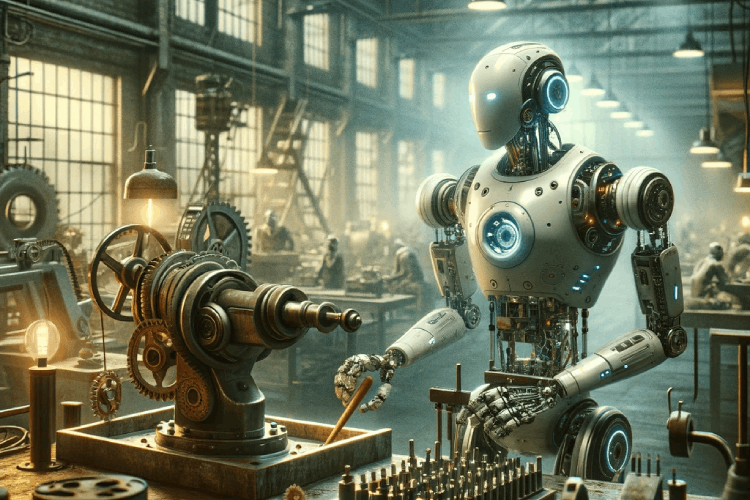From Industrial Machines To AI: How Technology Shapes A Promising And Job Rich Future
By MA. • • 4 Minutes
The introduction of machinery into industry has been a transformative process, marked by both fear and optimism. This process can be traced back to the Industrial Revolution, which began in the late 18th century.
Today, we see history repeating itself; we are now at the beginning of the AI era, with new Large Language Models emerging in the market, and every single tech company is trying to adapt to new AI technology that offers their end users (which a lot of them are companies) solutions to reduce costs and increase productivity, which some would say, may threaten people’s jobs.
If you are worried about the future that AI will bring, this article is written for you. We’ll discover together the history of the industrial revolution where machines were introduced, how did that play out? What was the outcome, so that we understand the similarities with AI and new technology whether they are going to take our jobs, or let us live in prosperity.
The Industrial Revolution: A Prelude to Prosperity
The late 18th century marked the beginning of the Industrial Revolution, a period characterized by the introduction of machinery in industries, starting with Britain's textile sector. This era laid the groundwork for modern industrialization, propelling significant economic growth. Between 1770 and 1870, Britain's economy expanded at an average of 2.1% annually, a notable increase attributed largely to industrial advancements. Similarly, in the United States, the expansion of the railroad network from 1830 into the early 20th century significantly boosted trade and economic development, multiplying the U.S. GDP by 20 times by 1900.
Despite initial fears of job displacement, the Industrial Revolution ultimately led to the creation of myriad new industries and job roles, ranging from manufacturing to maintenance and engineering. The emergence of sectors like the automotive industry further exemplifies the revolution's role in job creation and societal benefits, making goods more accessible and improving the overall quality of life.
From Automation to Digitalization: The 20th Century
The 20th century continued this trajectory of technological evolution, with automation and digitalization reshaping the economic and employment landscapes. The introduction of computers and digital technology across various sectors, while displacing certain jobs, also created new roles and industries, underscoring the economy's adaptability and growth potential.
The Dawn of the AI Era
Today, we stand at the precipice of the AI era, witnessing a surge in the development and application of Large Language Models and AI technologies aimed at enhancing productivity and reducing costs. Similar to past technological advancements, AI has sparked debates regarding its potential impact on employment. However, historical patterns suggest that, while disruptive, AI is likely to foster economic expansion and job creation.
AI's Economic and Employment Prospects
Evidence already points to AI's potential for creating new job categories, such as AI ethics, machine learning engineering, and data analysis, and enhancing productivity across sectors. For instance, AI applications in healthcare promise not only improved patient outcomes but also significant economic benefits through increased efficiency. Moreover, the need for reskilling and education highlights the parallel with the post-Industrial Revolution era, emphasizing the importance of digital literacy and complementary skills in the AI-dominated future.
Speed, Scale, and Global Impact
However, the AI revolution differs from its predecessors in its unprecedented speed, scale, and global reach, presenting unique challenges and opportunities. The global economy is poised to benefit significantly, with PwC estimating a potential contribution of up to $15.7 trillion by 2030. Similarly, the World Economic Forum predicts the creation of 97 million new jobs by 2025, driven by AI and automation.
Case Studies and Sector-Specific Impacts
Sector-specific analyses further illustrate AI's transformative potential. In healthcare, AI-driven innovations are expected to streamline patient care and save billions annually. In finance, AI is revolutionizing services through fintech innovations, contributing to job creation and economic growth. These examples underscore AI's role in not only automating tasks but also generating demand for new skills and roles.
Conclusion: Embracing the AI Era
The parallels between the machinery era of the Industrial Revolution and the current AI era are evident in both the apprehensions and the anticipated benefits. By examining history, we can foresee the AI era ushering in a new age of economic expansion, job creation, and quality of life improvements. The key to harnessing AI's potential lies in education, ethical considerations, and ensuring equitable access to technology. As we navigate the complexities of AI integration, drawing lessons from the past will be crucial in maximizing its benefits and mitigating challenges, steering society towards a prosperous and technologically advanced future.

